A grenade insignia is a form of emblem which represents a stylized old style of hand grenade, with a rising flame. This symbol is used as a charge in heraldry and is also featured on the uniforms of numerous military units.
A grenade insignia is a form of emblem which represents a stylized old style of hand grenade, with a rising flame. This symbol is used as a charge in heraldry and is also featured on the uniforms of numerous military units.
The insignia is featured on the uniforms of such military units as the:

A grenadier was historically an assault-specialist soldier who threw hand grenades in siege operation battles. The distinct combat function of the grenadier was established in the mid-17th century, when grenadiers were recruited from among the strongest and largest soldiers. By the 18th century, the grenadier dedicated to throwing hand grenades had become a less necessary specialist, yet in battle, the grenadiers were the physically robust soldiers who led vanguard assaults, such as storming fortifications in the course of siege warfare.

Jäger is a German military term referring to specific light infantry units.

Fusilier is a name given to various kinds of soldiers; its meaning depends on the historical context. While fusilier is derived from the 17th-century French word fusil – meaning a type of flintlock musket – the term has been used in contrasting ways in different countries and at different times, including soldiers guarding artillery, various elite units, ordinary line infantry and other uses.
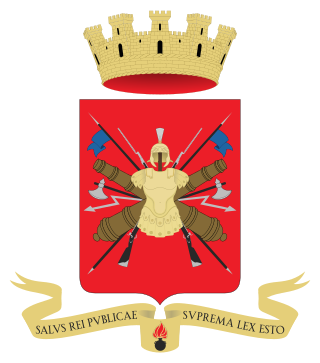
The Italian Army is the land force branch of the Italian Armed Forces. The army's history dates back to the Italian unification in the 1850s and 1860s. The army fought in colonial engagements in China, Libya, Northern Italy against the Austro-Hungarian Empire during World War I, Abyssinia before World War II and in World War II in Albania, Balkans, North Africa, the Soviet Union, and Italy itself. During the Cold War, the army prepared itself to defend against a Warsaw Pact invasion from the east. Since the end of the Cold War, the army has seen extensive peacekeeping service and combat in Afghanistan and Iraq. Its best-known combat vehicles are the Dardo infantry fighting vehicle, the Centauro tank destroyer and the Ariete tank and among its aircraft the Mangusta attack helicopter, recently deployed in UN missions. The headquarters of the Army General Staff are located in Rome opposite the Quirinal Palace, where the president of Italy resides. The army is an all-volunteer force of active-duty personnel.
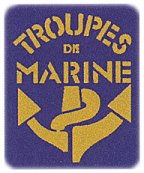
The Troupes de Marine or TDM, sometimes simply referred to as "French Marines" in English, are one of the major components of the French Army and comprise several specialties: infantry, airborne, armoured cavalry, artillery, engineering, and transmissions (signals). Characterized by their fundamental vocation for service beyond the seas, including in French overseas territories and, formerly, in French colonies, the Marines have taken part in all French military campaigns since the corps' foundation, both on home soil and in theaters of operations around the world. They are stationed in Metropolitan France, in many French overseas departments and territories, as well as in Africa.

The uniforms of the British Army currently exist in twelve categories ranging from ceremonial uniforms to combat dress. Uniforms in the British Army are specific to the regiment to which a soldier belongs. Full dress presents the most differentiation between units, and there are fewer regimental distinctions between ceremonial dress, service dress, barrack dress and combat dress, though a level of regimental distinction runs throughout.
On March 1, 1984 the Italian Institute for Disarmament, Development and Peace (Istituto di ricerche per il disarmo, lo sviluppo e la pace in Rome published the entire Italian Army order of battle down to company level – this was justified by the radical party as one of its core demands was total disarmament of Europe, even though the data which was published was top secret. The Radical Party dissolved in 1989 and the IRDISP followed suit in 1990. But Radio Radicale has survived, and the OrBat can still be found today on the homepage of the radio.

The Mechanized Brigade "Granatieri di Sardegna" is a mechanized infantry brigade of the Italian Army, based in Rome and central Italy. The brigade fields one of the oldest regiments of the Army and is one of the guard regiments of the President of Italy. The name of the unit dates back to the Kingdom of Sardinia and not the eponymous Mediterranean island of Sardinia. The brigade is part of the Division "Acqui".
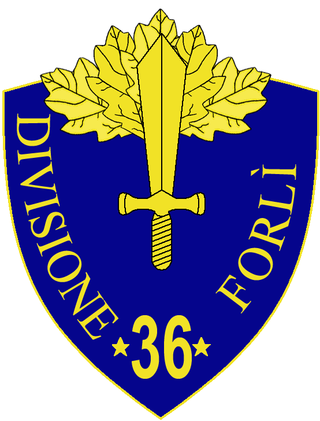
The 36th Infantry Division "Forlì" was a infantry division of the Royal Italian Army during World War II. The Forlì was classified as a mountain infantry division, which meant that the division's artillery was moved by pack mules instead of the horse-drawn carriages of line infantry divisions. Italy's real mountain warfare divisions were the six alpine divisions manned by Alpini mountain troops. The division was formed on 31 March 1939 and named for the city of Forlì. The division was based in Saluzzo and most of its troops were drafted in the surrounding Langhe region in southern Piedmont. The division's two infantry regiments were based in Alba (43rd) and Saluzzo (44th), with the division's artillery regiment also based in Saluzzo.
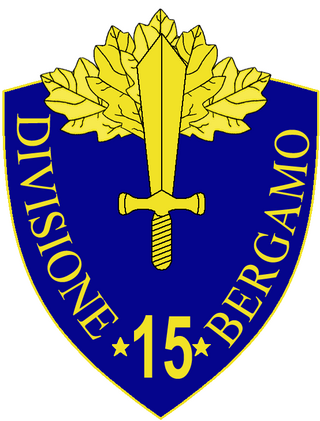
The 15th Infantry Division "Bergamo" was an infantry division of the Royal Italian Army during World War II. The Bergamo was based in Istria and named for the city of Bergamo.

The 44th Infantry Division "Cremona" was an infantry division of the Royal Italian Army during World War II. The Cremona was formed on 15 September 1939 by splitting the 20th Infantry Division "Curtatone and Montanara" into the 20th Infantry Division "Friuli" and 44th Infantry Division "Cremona". The division was named for the city of Cremona. The division served as occupation force on Corsica and fought German units after the Armistice of Cassibile was announced on 8 September 1943. The division then served with the Italian Co-belligerent Army and remained active until the 1975 Italian Army reform.

The 158th Infantry Division "Zara" was an infantry division of the Royal Italian Army during World War II. The Zara was formed on 1 September 1942 and named for the city of Zadar. The Zara was classified as an occupation infantry division. The division remained on the Dalmatian coast until it was disbanded on 9 September 1943 in the wake of the announcement of the Armistice of Cassibile.

Troops began wearing berets as a part of the headgear of military uniforms in some European countries during the 19th century; since the mid-20th century, they have become a component of the uniforms of many armed forces throughout the world. Military berets are usually pushed to the right to free the shoulder that bears the rifle on most soldiers, but the armies of some countries, mostly within Europe, South America, and Asia, have influenced the push to the left.
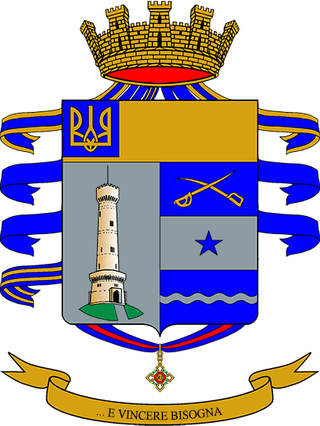
The 6th Bersaglieri Regiment is an active unit of the Italian Army based in Trapani in Sicily. The regiment is part of the army's infantry corps' Bersaglieri speciality and operationally assigned to the Mechanized Brigade "Aosta". The regiment was formed in 1861 by the Royal Italian Army with preexisting battalions. During World War I the regiment formed together with the 12th Bersaglieri Regiment the I Bersaglieri Brigade, which served on the Italian front.
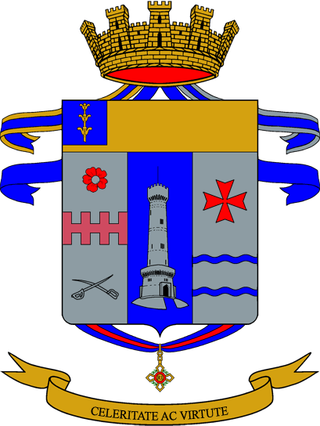
The 7th Bersaglieri Regiment is an active unit of the Italian Army based in Altamura in Apulia. The regiment is part of the army's infantry corps' Bersaglieri speciality and operationally assigned to the Mechanized Brigade "Pinerolo". The regiment was formed in 1871 by the Royal Italian Army with preexisting battalions. During World War I the regiment served on the Italian front. In World War II the regiment was assigned to the 102nd Motorized Division "Trento", with which it fought in the Western Desert Campaign in North Africa. In November 1942 the regiment was destroyed during the Second Battle of El Alamein. After being reformed in Tripoli in Libya the regiment fought in the Tunisian Campaign, where it was destroyed for a second time.

The 8th Bersaglieri Regiment is an active unit of the Italian Army based in Caserta in Campania. The regiment is part of the army's infantry corps' Bersaglieri speciality and operationally assigned to the Bersaglieri Brigade "Garibaldi". The regiment was formed in 1871 by the Royal Italian Army with preexisting battalions, which had served in the First Italian War of Independence, Crimean War, Second Italian War of Independence, and Third Italian War of Independence. During the Italo-Turkish War the regiment fought against Ottoman Army forces in Libya. During World War I the regiment served on the Italian front. During World War II the regiment was initially assigned to the 132nd Armored Division "Ariete", with which it fought in the Western Desert Campaign, and then to the 136th Armored Division "Giovani Fascisti", with which if fought in the Tunisian Campaign. For its service and sacrifice in the two North African campaigns the regiment was awarded two Gold Medals of Military Valor.

The 182nd Armored Infantry Regiment "Garibaldi" is an inactive unit of the Italian Army last based in Sacile in Friuli-Venezia Giulia. The regiment was part of the Italian Army's infantry arm and was last assigned to the Infantry Division "Folgore".

Italian Army gorget patches are worn by all army personnel on the collars of the shirts and jackets of their service uniforms and formal uniforms. The gorget patches identify the arm, corps, or speciality within an arm or corps a soldier belongs to. Generals wear golden stars instead of a gorget patches, while army recruits wear silver stars until they are assigned to a unit after basic training. Originally made from colored cloth, respectively embroidered cloth for Granatieri, Carabinieri and general staff members, gorget patches have been made since 1973 from enamelled metal.
The French Imperial Army was the land force branch of the French imperial military during the Napoleonic era.
The 8th Marching Division was a short-lived division of the Royal Italian Army during World War II. In the Italian military the term "Marching" refers to temporary units based in Italy to manage replacements for the operational units at the front.